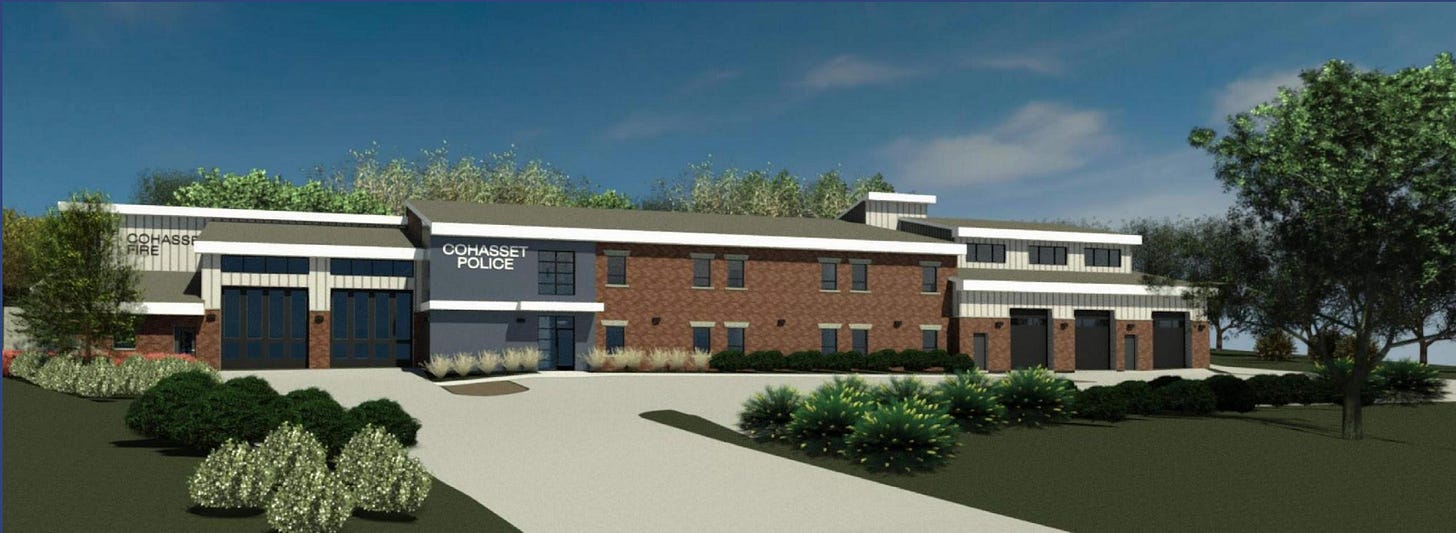COHASSET – Voters and taxpayers planning to attend the November 3rd Special Town Meeting (STM) expecting to vote on the Cohasset Public Safety Building project at 135 King Street may be surprised to learn the Select Board voted on October 7, 2025, to remove the project from the warrant and delay the critical vote until the spring.
The delay comes after the estimated cost of Phase 1 of the project—the construction of a new police headquarters and fire substation—skyrocketed from an initial appropriation of $10.4 million to an anticipated total cost nearing $27.5 million.
Here is an in-depth look at where this ambitious project originated, why its price tag escalated so dramatically, and why Town officials chose to hit the pause button just weeks before the planned vote.
--------------------------------------------------------------------------------
Part 1: The Urgent Need for a New Public Safety Hub
The push for a new facility stems from the severe inadequacies and non-compliance issues plaguing the existing building at 62 Elm Street, which was constructed in 1962.
Outdated and Non-Compliant Facilities
The current structure was built to serve a community whose population has since doubled. It was originally designed for only nine male police officers. Today, the Cohasset Police Department has approximately 27 sworn officers (male and female) and 10 civilian staff, totaling about 37 employees working in a space far too small (about 13,000 square feet).
Key deficiencies driving the need for a new building include:
• State Non-Compliance: The 1960s-era cell block is non-compliant with state regulations and the Police Department has been cited consistently by the state for the last five years. Police Chief William Quigley stated that the situation is “approaching gross negligence” and that the current building structure cannot be remodeled to bring the cell block into compliance.
• Code Failures: The Elm Street facility experiences monthly critical system failures, including plumbing, HVAC, and exterior envelope issues. Furthermore, the building does not meet current public safety facility standards or full ADA compliance requirements.
• Operational Bottlenecks: Emergency vehicles dispatched from Elm Street must travel through the congested Town Center via Main Street, slowing response times. Fire officials noted that the commuter rail often cuts the town in half, causing delays up to two minutes and impacting emergency response times.
The King Street Solution
The solution adopted by the Town is a two-phase plan. Phase 1 involves building a new primary police station and a fire substation at 135 King Street. This new location, strategically placed along Route 3A, is intended to significantly reduce emergency response times to the Beechwood area, North Cohasset, and schools west of the railroad tracks. The current average response time to these areas (from the single Elm Street station) is around 7 minutes and 55 seconds, which the new substation is projected to dramatically improve.
The proposed 21,300 to 23,600 square foot facility would house the Police Department headquarters, a two-bay Fire Substation, a dual-use Emergency Operations Center (EOC), and a secure municipal and school Data Center.
--------------------------------------------------------------------------------
Part 2: Why the Price Tag Tripled
In November 2023, the Cohasset STM approved $10.4 million for the project. By July 2025, officials announced they would need to seek an additional $17.1 million to $19 million, bringing the expected total project cost to $27.5 million.
Initial Miscalculation and Urgent Purchase
The dramatic cost increase stems largely from the initial approval being based on an incomplete assessment. Town officials explained that when the 135 King Street commercial office building became available in the summer of 2023, there was no formal project team. The Select Board moved quickly with a “best-guess estimate” of $10.4 million—without subject-matter consultation or a completed feasibility study—to secure the site for public safety use and prevent for-profit development. Of that initial allocation, $2.4 million was used specifically to purchase the property in April 2024.
The True Cost of a Public Safety Facility
Police Chief Quigley clarified that the initial appropriation did not account for the “substantial costs associated with upgrading the structure” from a standard Level II commercial facility to a Level IV public safety essential facility—a non-negotiable legal requirement for buildings housing first responders.
The revised $27.5 million figure accounts for several major, unforeseen expenses:
• Structural Conversion: Converting the building to Risk Category IV requires extensive structural work, including adding foundations, grade beams, and cross braces for lateral load rigidity, to ensure the building remains operational during catastrophes.
• Compliance Upgrades: The cost includes full ADA compliance, specialized infrastructure like a police sallyport (for secure prisoner transport), secure armory and evidence rooms, communications gear, and backup power.
• Market Inflation: Town officials cited “inflated public construction pricing in Massachusetts” and market volatility as contributing to the higher estimate.
Despite the cost spike, officials noted the project was scaled back two or three times from an original concept of 28,823 square feet to the current 21,300 square feet design, focusing only on operational needs and code requirements, calling the final plan a “modest station”.
Part 3: The Delay to Spring
The plan was to vote on the massive supplemental funding request at the STM on November 3, 2025. However, the Select Board, following recent public hearings, voted on October 7th to remove the funding article from the warrant and delay the vote until a spring Town Meeting.
The primary reasons cited for the delay centered on achieving greater clarity and public buy-in for the complex two-phase infrastructure initiative:
1. Lack of Clarity on Phase 2 Funding: Board members expressed concern that the funding and plans for Phase 2, the renovation of the existing 62 Elm Street facility into the Fire Department Headquarters, had not been “articulated in a clear and finite way”. The estimated cost for this second phase is an additional $7–$8 million.
2. Operational Questions: There was observed “lack of clarity from the fire department” regarding the operational structure for the two stations, including where Engine 1, Ambulance 1, Engine 2, and Ambulance 2 would be positioned.
3. Need for Benchmarking: The board felt more comprehensive benchmarking data comparing Cohasset’s size and costs per square foot to other communities was necessary to convince voters of the project’s necessity and value.
4. Public Readiness: Select Board Chair Ellen Maher concluded that the project was a “large amount of money for our town to spend” and needed more study to maximize its “chance of success” at the ballot box, given the public sentiment regarding the cost escalation.
While the delay allows time for a more “robust working group” to address these outstanding issues and pivot the design based on public feedback, officials cautioned that postponement poses financial risks. Board members noted that delaying construction is likely to result in even higher costs due to ongoing market volatility, and repeatedly canceling projects could cause Cohasset to gain a reputation among contractors as “tire kickers,” potentially leading to fewer bidders and less competitive prices in the future.
The new target for the vote is a Town Meeting in the spring. In the meantime, the town plans to hold continued public forums, shifting the focus from “selling the project to listening about to people about the project”.
Sources for this article include: the Town of Cohasset webpage, Select Board meetings, presentations on the building project, South Shore News, the Cohasset Anchor, the new publicsafety135.com, and investincohasset.com











